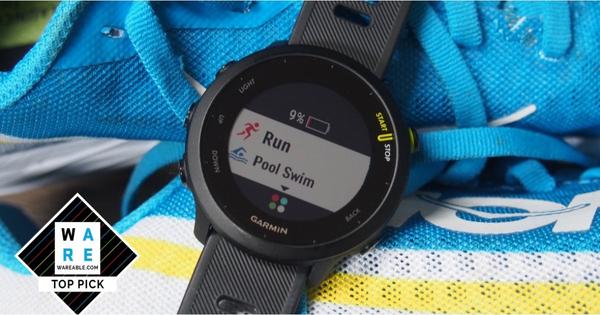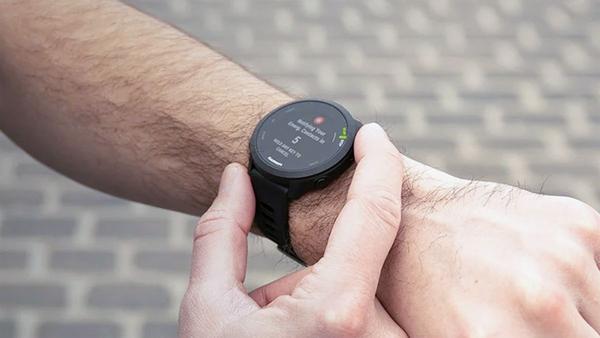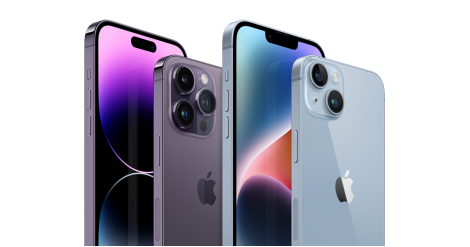Garmin Forerunner 55 review: The best running watch for beginners
Size: 42 x 42 x 11.6 mmWeight: 37 gramsDisplay size: 1.08 inchesDisplay resolution: 208 x 208Battery life: Smartwatch Mode: Up to 2 weeks/ GPS mode: Up to 20 hoursWater resistance: 5 ATM
Like its predecessors, the entry-level Garmin Forerunner 55 is a solid choice for those who want a fitness tracker with basic smartwatch capabilities, minus all the frills that tend to drive up the price.
It’s true that you won’t find a lot of sophisticated features on the Forerunner 55- there’s no onboard music storage, contactless payments, or fancy sensors that detect your blood oxygen levels. Yet with updated fitness features that were previously reserved for higher-end Forerunner models, the Forerunner 55 is a smartwatch that can not only help you begin a new running routine, but can train you to be a better runner overall. That’s why it’s one of thebest running watchesaround.
Garmin Forerunner 55: Price and availability
The recently launched Forerunner 55 retails for $199. Its silicone band comes in three different colors: black, white, or aqua. It’s available now in the U.S. and Canada, and will be available in other parts of the world later this summer.
Garmin Forerunner 55: Design
The Forerunner 55 looks basically identical to the previous Forerunner model, and that’s not a bad thing; the sleek, round face of theForerunner 45was a huge design upgrade in the Forerunner line, so it makes sense that Garmin wouldn’t want to change too much.
However, unlike the Forerunner 45 which was offered in either a 39mm or 42mm case size, you can only get the Forerunner 55 in one size (42mm). Despite having a relatively small wrist, I felt like the 55’s size was appropriate — it didn’t look overly bulky or conspicuous. In fact, the 42mm face served me quite well on runs, where I could very easily see my pace and distance information without having to contort my arm excessively. Still, it should be noted that I’d often hit the navigation buttons on the side of the watch’s face while doing push ups, something that rarely happens with my 40mmApple Watch Series 5.
Speaking of the navigation buttons, there are five of them on the Forerunner 55. In contrast to popular smartwatches like theFitbit Versa 3or theGalaxy Watch 3, the Forerunner doesn’t have a touchscreen display and instead relies on these buttons to perform various watch functions. I’ll admit, at first I thought this was going to be a feature I strongly disliked - I’m used to my Apple Watch, where all it takes is a quick swipe or tap to complete an action. But the more I used the Forerunner 55, the more I appreciated being able to start and stop a workout by pressing a button as opposed to swiping a screen and then tapping a small square. It was a lot easier and more efficient to mark the end of a long run this way, especially considering that long runs can leave me exasperated and prone to making mistakes (I’ve tapped the wrong icon on my Apple Watch far too many times to count).
Like the Forerunner 45, the Forerunner 55 doesn’t have interchangeable bands. While the black bezel and silicone band of the 55 I tested transitioned well enough from leggings and sports bras to jeans and blouses, I wouldn't necessarily feel like I could wear it to a wedding or formal event. If you’re looking for a Garmin smartwatch that will pair better with a bridesmaid’s dress or tux while still tracking your steps and heart rate, check out their Venu line.
Garmin Forerunner 55: Display
Even on the sunniest days, I could see the Forerunner 55’s transflective MIP display without an issue. A “light” button would illuminate the watch face if I needed a bit more brightness, but I very rarely needed it outside of checking the time in the middle of the night.
Garmin Forerunner 55: GPS
The Forerunner 55 has built-in GPS that can provide pace, distance, and time information for runs and other outdoor distance workouts.
I never had to wait more than five seconds for the Forerunner 55 to lock on to a GPS signal. This is a vast improvement when compared to our test of the Forerunner 45, which took anywhere between 15-30 seconds to do the same. Testing the GPS capabilities in different areas (Brooklyn, Manhattan, and western Long Island) resulted in similar times.

The newest Forerunner continues to offer innovative GPS safety features like incident detection, which lets users send a message to selected contacts in case of a fall or other emergency. In order to use this feature though, you’ll need to keep your connected smartphone on you during your runs. If you’d like to run phone-free, theForerunner 945 LTEis a better choice.
Garmin also offers “LiveTrack” on the Forerunner 55, which allows friends and family to see your real-time location during your athletic pursuits (a fun and useful option for your next Turkey Trot).
Garmin Forerunner 55: Run tracking
While the Forerunner 55 is a decent introductory smartwatch for anyone who’s active, it really shines as an option for the beginner or intermediate runner.
Sure, it provides all the standard information that any smartwatch with GPS will — your pace, split times, elapsed time, and mileage. But the Forerunner 55 goes a step further with three aspects geared towards improving your conditioning, which until recently were only found on the more expensive Forerunner models: PacePro downloads, suggested recovery times, and suggested workouts.
As someone who isn’t new to running but definitely has a lot to learn, I find one of my biggest hurdles is losing steam after the first few miles of a longer run. In this regard, the PacePro feature was a total game changer. Within the Garmin Connect smartphone app (available for iPhone or Android), users have the choice of either selecting a course and entering it manually, or selecting a race distance. After inputting a goal time and goal pace, you can create a pacing strategy. Send this plan to your Forerunner 55, and your watch will give you speed and cadence alerts (a gentle but noticeable buzz) if you’re running outside of your predetermined rates. Choosing a negative split strategy allowed me to take more time at the beginning of my route and speed up towards the end. For the first time in recent history, I didn’t feel like I’d been hit by a minivan at the end of a longer run.
Recovery can also be a challenge. Maybe it’s because I have a hard time accepting that I’m not in my early (who are we kidding, mid) 30s anymore, but trying to get three runs in a week that yielded the same speed and perceived effort was starting to get frustratingly impossible. After each run with the Forerunner 55, users are given suggested recovery times. If you try to embark on a run before your recovery time is complete, the Forerunner will suggest you continue to rest instead (you can dismiss this suggestion, if you prefer).
Once you’ve rested, the Forerunner 55 will give you suggested workouts tailored to your training history, fitness level (measured as Vo2 max), and recovery. Following the recommended rest period and suggested workouts allowed me to feel a lot more refreshed and energized in my long runs, even if I had to skip a training day and go a bit slower than usual. Quality over quantity, as the saying goes.
The Forerunner 55’s standard run tracking display shows three important figures, distance, elapsed time, and pace, although you can customize the display if you’d like to see different metrics. Using the “down” button to navigate through various displays will give you lap times, lap pace, lap distance, and your current heart rate. After each mile, the Forerunner 55 will buzz and give your overall run time and your last mile’s pace.
Other smartwatches like the Apple Watch will give you a few more metrics on its main screen, but I found that I preferred seeing just the pace, elapsed time, and distance. However, if you’re an advanced runner who needs more data at your immediate disposal, you may find the Forerunner 55 lacking.
Garmin Forerunner 55: Activity tracking
The Forerunner 55 expands its activity profiles with the addition of pool swimming, HIIT, Pilates, and breathwork. Selections like Yoga that used to require an app to add now come standard, along with elliptical, stair stepper, treadmill, biking, and of course running.
While activity profiles on the Forerunner 55 are adequate if not expansive, there is one common workout that is sorely missed (and necessary for overall health): strength training. This is unfortunate, given that the Connect app offers several well-rounded strength-based workout routines. You can always select the “Other” activity profile option if you want to track your time pumping iron, but for dedicated strength training tracking, take a look at Garmin Forerunner 945.
Garmin Forerunner 55: Sleep tracking
The Forerunner 55’s sleep tracking is relatively basic, but it’s useful if getting more sleep is one of your health goals. Like the Versa 3 and theApple Watch SE, the Forerunner 55 records your time spent in light sleep, deep sleep, REM sleep, and awake, then displays everything on an easy-to-read graph in the Connect App.
While seeing this information was interesting, I wasn’t sure exactly how to interpret it - is 2 hours of REM sleep enough? Too much? That’s where an overall summary (like the Fitbit Versa 3’s “Sleep Score”) would prove helpful, especially since recovery is a big focus with the Forerunner 55.
The accuracy of Forerunner 55’s sleep tracking was a bit off during testing. On one night, the watch detected that I went to bed at 8pm and woke at 6:30am. While I often dream of getting 10 hours of sleep, I haven’t had that pleasure since my high school days. However, the app does allow you to edit your sleep and wake times if the watch records them incorrectly.
Garmin Forerunner 55: Health tracking
In addition to tracking your activity and sleep, the Forerunner 55 also monitors your steps (and buzzes when you’ve reached your recommended daily step goal), respiration rate, stress levels, calories burned, menstrual cycles, and pregnancy symptoms.
A feature exclusive to Garmin watches is the Body Battery, a score numbered from 0-100 that takes into account your Heart Rate Variability (HRV), stress, and activity to estimate a user’s energy reserves throughout the day. Moments of rest or sleep will “charge” your battery, while moments of stress and activity will “drain” your battery. This is a helpful insight when planning heavy workout days, or when trying to decide if you should binge one more episode or go to sleep early.
Garmin Forerunner 55: Garmin connect app
All the data your Forerunner 55 gathers is compiled nicely in the Garmin Connect smartphone app. In addition to your daily stats, you can see personal achievements and milestones, join or create challenges, and connect with friends on social media. If you’ve set your sights on a 5k, 10k, or half-marathon, the Connect app offers several thorough (and free) training plans geared towards your desired distance and completion goals.
The Connect app also offers a fairly comprehensive library of workouts for all levels, from strength and endurance to flexibility and mobility. There are several programs available that use only bodyweight, but most require various pieces of equipment. In addition, you can also use the Garmin Connect IQ app to download any number of additional watchfaces.
The Forerunner 55 can also display notifications, calendar alerts, and weather — and even control the music playing on your phone — but its smartwatch functions end there. For instance, it lacks mobile payments, and you can’t download music to the watch itself.
Garmin Forerunner 55: Battery
According to Garmin, a fully charged Forerunner 55 can last up to two weeks in Smartwatch mode and 20 hours in GPS mode, which is a significant increase from its predecessor’s battery life expectations. Those stats are even more impressive when pitted against competitors like the Versa 3 (6 days, or 12 hours with continuous GPS) or the Samsung Galaxy Watch3 (2 days).
A week’s worth of 24 hour-a-day tracking sapped about half of the Forerunner 55’s available power. A lengthy run or workout would only deplete the battery by about 2%, even in GPS mode. This was a welcome change from my Apple Watch Series 5, which I usually have to charge every 12 hours to ensure it won’t die on me in the middle of a workout.
Garmin Forerunner 55: Verdict
You may not notice many differences between the new Forerunner 55 and its most immediate predecessor, but the updates that Garmin has made will make a world of difference for the newly initiated runner. This is a watch that’s focused on helping the novice learn how to train and rest appropriately, without much attention to the bells and whistles that you’d find with an Apple Watch SE or a Galaxy Watch 3.
The Forerunner 55 isn’t the most versatile smartwatch on the market, but it offers the basics. If you’re an advanced athlete, you may find a higher-end Forerunner model, like the Forerunner 245 Music, which lets you download tunes to the watch itself. But if you’ve recently laced up a pair of running shoes for the first time, and are staring down the road with a 10-minute mile goal, you’d be hard pressed to find a better and more economical choice than the Forerunner 55.



